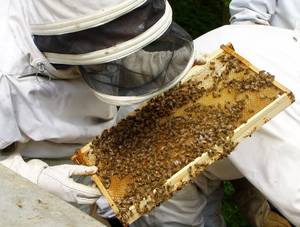This modern beekeeper’s mead recipe is designed to use the water after washing the cappings. I assume they don’t use fairy liquid when washing the cappings! You don’t have to be a beekeeper to make it and alternatives are given in the ingredients.
 Honey has never been cheap to produce in Britain and the origins of this recipe come from a time when nothing was wasted, especially something as expensive as sweetness. Something we forget these days when sugar is cheap and bland foreign honey imported in barrels if not tankers.
Honey has never been cheap to produce in Britain and the origins of this recipe come from a time when nothing was wasted, especially something as expensive as sweetness. Something we forget these days when sugar is cheap and bland foreign honey imported in barrels if not tankers.
It is advised to use soft rain water as ordinary tap water will often have chlorine flavour which will taint the mead, but this is not absolutely essential. Modern water filters like the Brita system will get rid of any chlorine flavour in the waster.
The proportion of honey to water can be varied: less honey produces a drier mead while more gives a sweeter, fuller-bodied wine.
Ingredients for beekeeper’s mead recipe
- Water from washing the cappings
- Honey
- 2 tablespoons of strong black tea (no milk or sugar!)
- 1 Lemon
- Wine Yeast
- Yeast Nutrient
Method for beekeeper’s mead recipe
- Start the yeast 2 days ahead. Take a sterilised jar and add a tablespoon of honey. Pour on a ¼ pint to ½ pint of boiling water and stir to mix. When cooled to 20°C or below, add the yeast and yeast nutrient. Keep covered but not airtight, a muslin cover affixed with a rubber band or string is ideal.
- To use the water left after washing the cappings, strain it well through muslin into a pan and test the specific gravity with a hydrometer. The specific gravity should be between 1.06 and 1.12. More honey and water can be added as required to raise the SG.
Alternatively start with 3 lb to 3½ lb honey and add water to make up to a gallon - Add the tea and juice of the lemon. You can also zest the lemon, cover with boiling water and allow to soak for half an hour before straining into the pan.
- Sterilize the liquid by bringing it to the boil and allow to simmer for a few minutes. Skim off the scum, cover and leave it to cool in a fermenting bin or wine bucket with a lid.
- Once cooled below 20°C add the pre-made yeast starter and yeast nutrient
- A fierce fermentation should begin quickly. After a few days to a week the rate will have slowed and the must can be poured into a demijohn and topped up to the gallon with cooled boiled water prior to fitting the air-lock.
- Keep in a warm place until fermentation stops and then rack off into a sterilised demijohn
- Place the demijohn in a cool place for six months to a year and then bottle or add a Campden tablet to stop fermentation and then rack off into bottles.
Mead improves with age and is best stored for at least a year prior to drinking. Some of the best meads mature for 7 years prior to drinking.


Leave a Reply